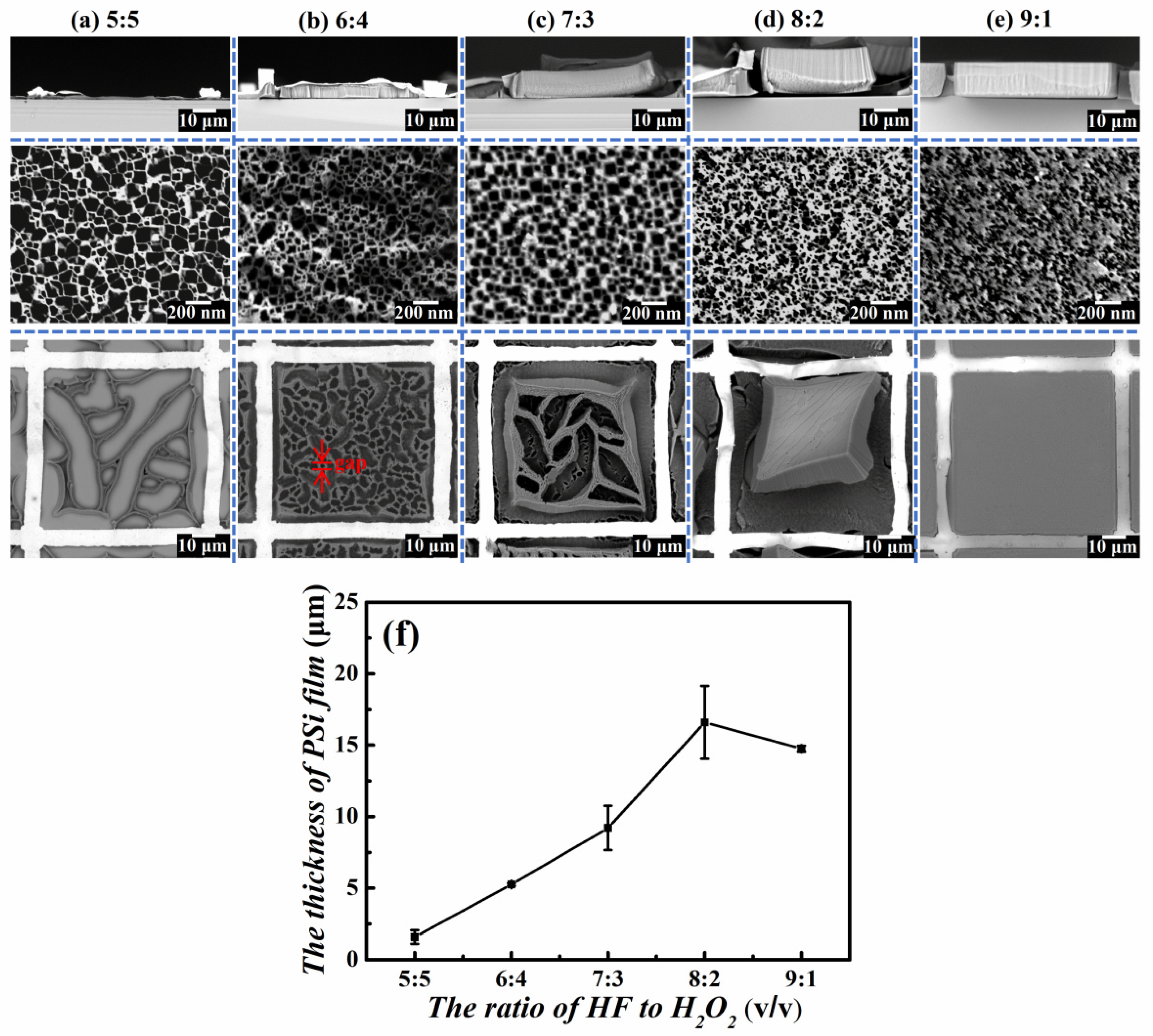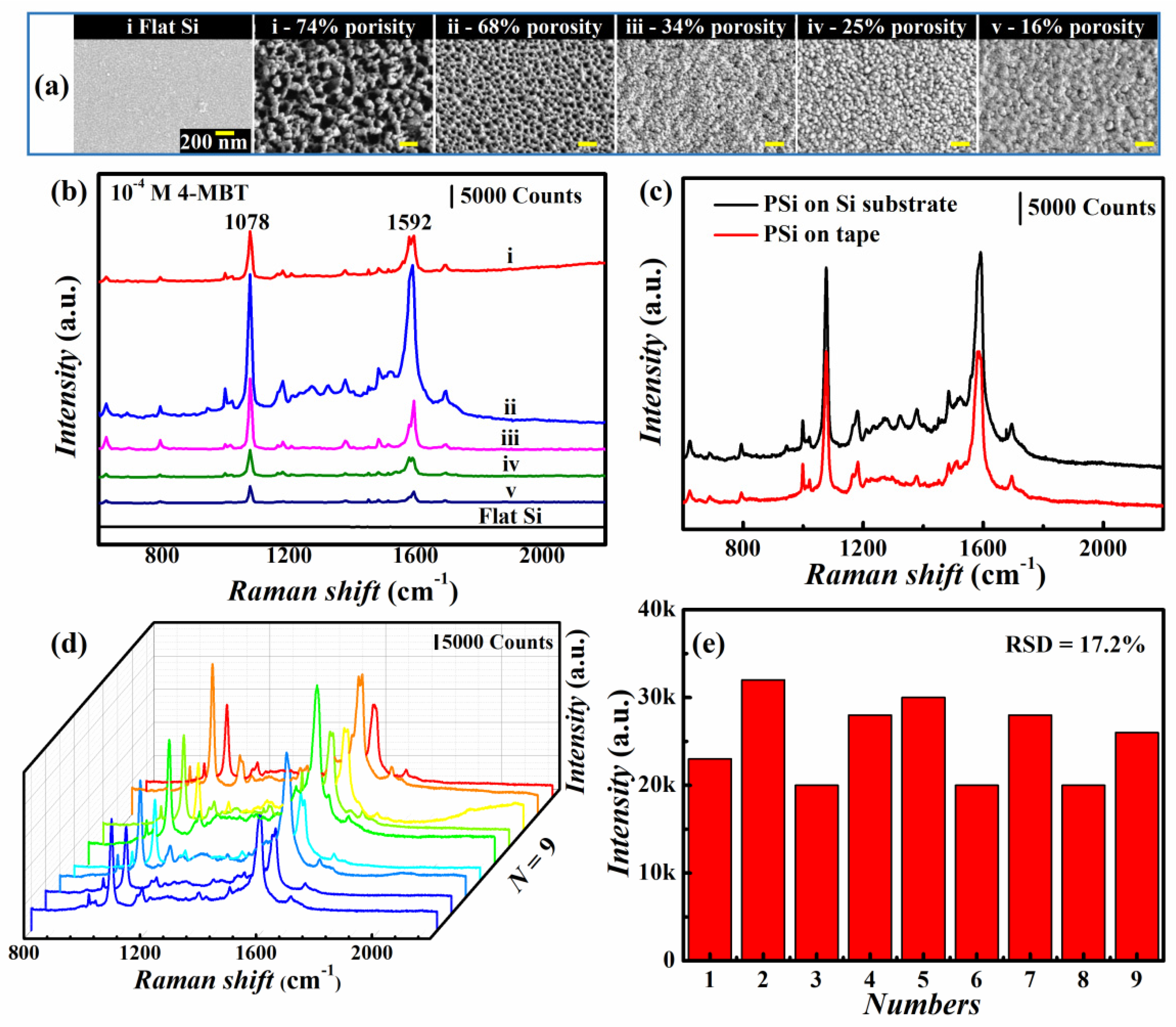Wafer-Scale Fabrication and Transfer of Porous Silicon Films as Flexible Nanomaterials for Sensing Application
Abstract
:1. Introduction
2. Materials and Methods
2.1. Materials
2.2. Fabrication of PSi Films
2.3. Vertical Transfer PSi Films to Flexible Substrate
2.4. Wettability Measurements
2.5. SERS Measurements
2.6. Other Characterizations
3. Results
3.1. Fabrication of PSi Films on Si Substrate
3.2. Transfer of PSi Films
3.3. Surface Wettability
3.4. SERS Measurements
4. Conclusions
Supplementary Materials
Author Contributions
Funding
Data Availability Statement
Acknowledgments
Conflicts of Interest
References
- Xi, F.; Zhang, Z.; Wan, X.; Li, S.; Ma, W.; Chen, X.; Chen, R.; Luo, B.; Wang, L. High-performance porous silicon/nanosilver anodes from industrial low-grade silicon for lithium-ion batteries. ACS Appl. Mater. Interfaces 2020, 12, 49080–49089. [Google Scholar] [CrossRef]
- An, W.; Gao, B.; Mei, S.; Xiang, B.; Fu, J.; Wang, L.; Zhang, Q.; Chu, P.K.; Huo, K. Scalable synthesis of ant-nest-like bulk porous silicon for high-performance lithium-ion battery anodes. Nat. Commun. 2019, 10, 1447. [Google Scholar] [CrossRef] [PubMed] [Green Version]
- Graham, S.A.; Boyko, E.; Salama, R.; Segal, E. Mass transfer limitations of porous silicon-based biosensors for protein detection. ACS Sens. 2020, 5, 3058–3069. [Google Scholar] [CrossRef]
- Mariani, S.; Robbiano, V.; Strambini, L.M.; Debrassi, A.; Egri, G.; Daehne, L.; Barillaro, G. Layer-by-layer biofunctionalization of nanostructured porous silicon for high-sensitivity and high-selectivity label-free affinity biosensing. Nat. Commun. 2018, 9, 5256. [Google Scholar] [CrossRef]
- Salonen, J.; Makila, E. Thermally carbonized porous silicon and its recent applications. Adv. Mater. 2018, 30, 1703819. [Google Scholar] [CrossRef] [PubMed] [Green Version]
- Li, W.; Liu, Z.; Fontana, F.; Ding, Y.; Liu, D.; Hirvonen, J.T.; Santos, H.A. Tailoring porous silicon for biomedical applications: From drug delivery to cancer immunotherapy. Adv. Mater. 2018, 30, 1703740. [Google Scholar] [CrossRef]
- Rashed, M.A.; Harraz, F.A.; Faisal, M.; El-Toni, A.M.; Alsaiari, M.; Al-Assiri, M.S. Gold nanoparticles plated porous silicon nanopowder for nonenzymatic voltammetric detection of hydrogen peroxide. Anal. Biochem. 2021, 615, 114065. [Google Scholar] [CrossRef] [PubMed]
- Sohn, M.; Lee, D.G.; Park, H.I.; Park, C.; Choi, J.H.; Kim, H. Microstructure controlled porous silicon particles as a high capacity lithium storage material via dual step pore engineering. Adv. Funct. Mater. 2018, 28, 1800855. [Google Scholar] [CrossRef]
- Myndrul, V.; Viter, R.; Savchuk, M.; Shpyrka, N.; Erts, D.; Jevdokimovs, D.; Silamikelis, V.; Smyntyna, V.; Ramanavicius, A.; Iatsunskyi, I. Porous silicon based photoluminescence immunosensor for rapid and highly-sensitive detection of Ochratoxin A. Biosens. Bioelectron. 2018, 102, 661–667. [Google Scholar] [CrossRef]
- Rajkumar, K.; Pandian, R.; Sankarakumar, A.; Kumar, R.T.R. Engineering silicon to porous silicon and silicon nanowires by metal-assisted chemical etching: Role of Ag size and electron-scavenging rate on morphology control and mechanism. ACS Omega 2017, 2, 4540–4547. [Google Scholar] [CrossRef]
- Wareing, N.; Szymanski, K.; Akkaraju, G.R.; Loni, A.; Canham, L.T.; Gonzalez-Rodriguez, R.; Coffer, J.L. In vitro gene delivery with large porous silicon nanoparticles fabricated using cost-effective, metal-assisted chemical etching. Small 2017, 13, 1602739. [Google Scholar] [CrossRef] [PubMed]
- Fang, Y.; Jiang, Y.W.; Ledesrna, H.A.; Yi, J.S.; Gao, X.; Weiss, D.E.; Shi, F.Y.; Tian, B.Z. Texturing silicon nanowires for highly localized optical modulation of cellular dynamics. Nano Lett. 2018, 18, 4487–4492. [Google Scholar] [CrossRef] [PubMed]
- Zhu, B.; Liu, W.J.; Ding, S.J.; Zhang, D.W.; Fan, Z.Y. Formation mechanism of heavily doped silicon mesopores induced by Pt nanoparticle-assisted chemical etching. J. Phys. Chem. C 2018, 122, 21537–21542. [Google Scholar] [CrossRef]
- Kim, D.H.; Lee, W.; Myoung, J.M. Flexible multi-wavelength photodetector based on porous silicon nanowires. Nanoscale 2018, 10, 17705–17711. [Google Scholar] [CrossRef] [PubMed]
- Kim, Y.J.; Yoo, Y.J.; Lee, G.J.; Yoo, D.E.; Lee, D.W.; Siva, V.; Song, H.; Kang, I.S.; Song, Y.M. Enlarged color gamut representation enabled by transferable silicon nanowire arrays on metal-insulator-metal films. ACS Appl. Mater. Interfaces 2019, 11, 11849–11856. [Google Scholar] [CrossRef] [PubMed]
- Kim, H.; Lee, H.S.; Jeon, Y.; Park, W.; Zhang, Y.; Kim, B.; Jang, H.; Xu, B.; Yeo, Y.; Kim, D.R.; et al. Bioresorbable, miniaturized porous silicon needles on a flexible water-Soluble backing for unobtrusive, sustained delivery of chemotherapy. ACS Nano 2020, 14, 7227–7236. [Google Scholar] [CrossRef]
- Weisse, J.M.; Lee, C.H.; Kim, D.R.; Zheng, X. Fabrication of flexible and vertical silicon nanowire electronics. Nano Lett. 2012, 12, 3339–3343. [Google Scholar] [CrossRef]
- Weisse, J.M.; Lee, C.H.; Kim, D.R.; Cai, L.; Rao, P.M.; Zheng, X. Electroassisted transfer of vertical silicon wire arrays using a sacrificial porous silicon layer. Nano Lett. 2013, 13, 4362–4368. [Google Scholar] [CrossRef]
- Wang, Y.; Zhang, X.; Gao, P.; Shao, Z.; Zhang, X.; Han, Y.; Jie, J. Air heating approach for multi layer etching and roll-to-roll transfer of silicon nanowire arrays as SERS substrates for high sensitivity molecule detection. ACS Appl. Mater. Interfaces 2014, 6, 977–984. [Google Scholar] [CrossRef]
- Zhong, X.; Qu, Y.Q.; Lin, Y.C.; Liao, L.; Duan, X.F. Unveiling the formation pathway of single crystalline porous silicon nanowires. ACS Appl. Mater. Interfaces 2011, 3, 261–270. [Google Scholar] [CrossRef] [Green Version]
- Li, X.; Xiao, Y.; Yan, C.; Song, J.W.; Talalaev, V.; Schweizer, S.L.; Piekielska, K.; Sprafke, A.; Lee, J.H.; Wehrspohn, R.B. Fast electroless fabrication of uniform mesoporous silicon layers. Electrochim. Acta 2013, 94, 57–61. [Google Scholar] [CrossRef]
- Li, X.; Bohn, P.W. Metal-assisted chemical etching in HF/H(2)O(2) produces porous silicon. Appl. Phys. Lett. 2000, 77, 2572–2574. [Google Scholar] [CrossRef]
- Herino, R.; Bomchil, G.; Barla, K.; Bertrand, C.; Ginoux, J.L. Porosity and pore size distributions of porous silicon layers. J. Electrochem. Soc. 1987, 134, 1994–2000. [Google Scholar] [CrossRef]
- Chartier, C.; Bastide, S.; Levy-Clement, C. Metal-assisted chemical etching of silicon in HF-H2O2. Electrochim. Acta 2008, 53, 5509–5516. [Google Scholar] [CrossRef]
- Mason, M.D.; Sirbuly, D.J.; Buratto, S.K. Correlation between bulk morphology and luminescence in porous silicon investigated by pore collapse resulting from drying. Thin Solid Films 2002, 406, 151–158. [Google Scholar] [CrossRef]
- Lin, C.H.; Lee, S.C.; Chen, Y.F. Morphologies and photoluminescence of porous silicon under different etching and oxidation conditions. J. Appl. Phys. 1994, 75, 7728–7736. [Google Scholar] [CrossRef]
- Zhang, Z.; Wang, Y.; Hansen, P.A.S.; Du, K.; Gustavsen, K.R.; Liu, G.; Karlsen, F.; Nilsen, O.; Xue, C.; Wang, K. Black silicon with order-disordered structures for enhanced light trapping and photothermic conversion. Nano Energy 2019, 65, 103992. [Google Scholar] [CrossRef]
- Canham, L.T.; Cullis, A.; Pickering, C.; Dosser, O.; Cox, T.; Lynch, T. Luminescent anodized silicon aerocrystal networks prepared by supercritical drying. Nature 1994, 368, 133. [Google Scholar] [CrossRef]
- Grüning, U.; Yelon, A. Capillary and Van der Waals forces and mechanical stability of porous silicon. Thin Solid Films 1995, 255, 135–138. [Google Scholar] [CrossRef]
- Belmont, O.; Bellet, D.; Brechet, Y. Study of the cracking of highly porous p+ type silicon during drying. J. Appl. Phys. 1996, 79, 7586–7591. [Google Scholar] [CrossRef]
- Belmont, O.; Faivre, C.; Bellet, D.; Brechet, Y. About the origin and the mechanisms involved in the cracking of highly porous silicon layers under capillary stresses. Thin Solid Films 1996, 276, 219–222. [Google Scholar] [CrossRef]
- Gaev, D.S.; Rekhviashvili, S.S. Kinetics of crack formation in porous silicon. Semiconductors 2012, 46, 137–140. [Google Scholar] [CrossRef]
- Feng, X.J.; Jiang, L. Design and creation of superwetting/antiwetting surfaces. Adv. Mater. 2006, 18, 3063–3078. [Google Scholar] [CrossRef]
- Chan, S.; Kwon, S.; Koo, T.W.; Lee, L.P.; Berlin, A.A. Surface-enhanced Raman scattering of small molecules from silver-coated silicon nanopores. Adv. Mater. 2003, 15, 1595–1598. [Google Scholar] [CrossRef]
- Al-Syadi, A.M.; Faisal, M.; Harraz, F.A.; Jalalah, M.; Alsaiari, M. Immersion-plated palladium nanoparticles onto meso-porous silicon layer as novel SERS substrate for sensitive detection of imidacloprid pesticide. Sci. Rep. 2021, 11, 9174. [Google Scholar] [CrossRef] [PubMed]
- Ge, D.; Wei, J.; Ding, J.; Zhang, J.; Ma, C.; Wang, M.; Zhang, L.; Zhu, S. Silver Nano-Dendrite-Plated Porous Silicon Substrates Formed by Single-Step Electrochemical Synthesis for Surface-Enhanced Raman Scattering. ACS Appl. Nano Mater. 2020, 3, 3011–3018. [Google Scholar] [CrossRef]
- Wang, J.; Jin, M.; Gong, Y.; Li, H.; Wu, S.; Zhang, Z.; Zhou, G.; Shui, L.; Eijkel, J.C.T.; van den Berg, A. Continuous fabrication of microcapsules with controllable metal covered nanoparticle arrays using droplet microfluidics for localized surface plasmon resonance. Lab Chip 2017, 17, 1970–1979. [Google Scholar] [CrossRef]
- Aksu, S.; Huang, M.; Artar, A.; Yanik, A.A.; Selvarasah, S.; Dokmeci, M.R.; Altug, H. Flexible plasmonics on unconventional and nonplanar substrates. Adv. Mater. 2011, 23, 4422–4430. [Google Scholar] [CrossRef]
- Kim, D.; Yun, H.S.; Das, B.; Rhie, J.; Vasa, P.; Kim, Y.I.; Choa, S.H.; Park, N.; Lee, D.; Bahk, Y.M.; et al. Topology-changing broadband metamaterials enabled by closable nanotrenches. Nano Lett. 2021, 21, 4202–4208. [Google Scholar] [CrossRef]
- Das, B.; Yun, H.S.; Park, N.; Jeong, J.; Kim, D.S. A Transformative metasurface based on zerogap embedded template. Adv. Opt. Mater. 2021, 9, 2002164. [Google Scholar] [CrossRef]
- Qu, C.; Guo, Q.; Huang, G.; Mei, Y. Local Cracking-induced scalable flexible silicon nanogaps for dynamically tunable surface enhanced Raman scattering substrates. Adv. Mater. Interfaces 2021, 8, 2100661. [Google Scholar] [CrossRef]
- Xie, L.; Zeng, H.; Zhu, J.; Zhang, Z.; Sun, H.-b.; Xia, W.; Du, Y. State of the art in flexible SERS sensors toward label-free and onsite detection: From design to applications. Nano Res. 2022. [Google Scholar] [CrossRef]
- Xu, K.; Zhou, R.; Takei, K.; Hong, M. Toward flexible surface-enhanced Raman scattering (SERS) sensors for point-of-care diagnostics. Adv. Sci. 2019, 6, 1900925. [Google Scholar] [CrossRef] [PubMed]
- Wang, P.; Wu, L.; Lu, Z.; Li, Q.; Yin, W.; Ding, F.; Han, H. Gecko-inspired nanotentacle surface-enhanced Raman spectroscopy substrate for sampling and reliable detection of pesticide residues in fruits and vegetables. Anal. Chem. 2017, 89, 2424–2431. [Google Scholar] [CrossRef] [PubMed]
- Lee, Y.H.; Shi, W.; Lee, H.K.; Jiang, R.; Phang, I.Y.; Cui, Y.; Isa, L.; Yang, Y.; Wang, J.; Li, S.; et al. Nanoscale surface chemistry directs the tunable assembly of silver octahedra into three two-dimensional plasmonic superlattices. Nat. Commun. 2015, 6, 6990. [Google Scholar] [CrossRef]
- Jayrarn, N.D.; Aishwarya, D.; Sonia, S.; Mangalaraj, D.; Kumar, P.S.; Rao, G.M. Analysis on superhydrophobic silver decorated copper oxide nanostructured thin films for SERS studies. J. Colloid Interf. Sci. 2016, 477, 209–219. [Google Scholar] [CrossRef]
- Wu, H.; Luo, Y.; Hou, C.; Huo, D.; Zhou, Y.; Zou, S.; Zhao, J.; Lei, Y. Flexible bipyra-mid-AuNPs based SERS tape sensing strategy for detecting methyl parathion on vegetable and fruit surface. Sensor. Actuat. B-Chem. 2019, 285, 123–128. [Google Scholar] [CrossRef]





Publisher’s Note: MDPI stays neutral with regard to jurisdictional claims in published maps and institutional affiliations. |
© 2022 by the authors. Licensee MDPI, Basel, Switzerland. This article is an open access article distributed under the terms and conditions of the Creative Commons Attribution (CC BY) license (https://creativecommons.org/licenses/by/4.0/).
Share and Cite
Lu, H.; Jin, M.; Zhang, Z.; Wu, S.; Shui, L. Wafer-Scale Fabrication and Transfer of Porous Silicon Films as Flexible Nanomaterials for Sensing Application. Nanomaterials 2022, 12, 1191. https://doi.org/10.3390/nano12071191
Lu H, Jin M, Zhang Z, Wu S, Shui L. Wafer-Scale Fabrication and Transfer of Porous Silicon Films as Flexible Nanomaterials for Sensing Application. Nanomaterials. 2022; 12(7):1191. https://doi.org/10.3390/nano12071191
Chicago/Turabian StyleLu, Han, Mingliang Jin, Zongbao Zhang, Sujuan Wu, and Lingling Shui. 2022. "Wafer-Scale Fabrication and Transfer of Porous Silicon Films as Flexible Nanomaterials for Sensing Application" Nanomaterials 12, no. 7: 1191. https://doi.org/10.3390/nano12071191






